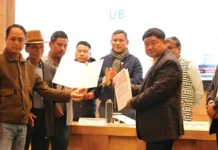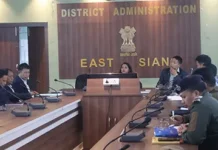[ND Thongdok]
In the wee hours of 8 December, an auspicious day as per the Buddhist calendar, a special drum will be beaten from a small hillock in the middle of Rupa village in West Kameng district, announcing the commencement of Khik-Saba festival of the Shertukpens – to be precise, of the Tukpens residing in the Rupa valley.
This small hillock is called the holy kamcha sree. The drum is sounded when the confluence of the moon and the seven stars takes place amidst the chanting of specially ordained priests called khikzizis.
Khik-Saba is a typical Shertukpen festival which the Sherdukpens have been celebrating zealously since the time of our progenitor Asu-Gyaptong, somewhere between the 15th and the 16th century. Legend has it that this colourful festival started when Asu- Gyaptong conquered Rupa (Tukpen Lomekhar) after killing the then ruler of Rupa, Kelling Sowa Gangan.
This festival is basically the worship of the mountain deities of the Shertukpens, Sungkhits and Sorokhits. This is a day and night festival where rituals are performed by the khikzizis for the wellbeing of all.
Days before the festival, a group of people chosen from the villages under the Tukpen Village Council (TVC) are sent to Dhekiajuli subdivision in Assam to collect areca nuts. These areca nuts are generously donated by the villagers of Assam, as they are offered to the deities during the festival. This has been a tradition since time immemorial. These areca nuts are offered along with other fruits like banana, sugarcane and tubers to the deities. As a customary practice, the tuber is brought by the neighbouring Bugun tribe.
However, the main protagonist of the festival are the nine clan houses – Thongdok, Thongchi, Thongon, Mosobi, Thongdok-achung, Khrimey, Dingla, Megeji and Ubu-Chilu. All festivities take place in these clan houses, which are collectively called khik-spus.
Khik-Saba is a weeklong festival, wherein, on the first day, after the drum is sounded, late in the afternoon a ceremony is held at a location called ‘usher’, where the sanctified areca nuts are distributed to all the nine clan khik-spus, and also to the households. This is followed in the evening by a community feast and distribution of fish collected from the Ziding Kho river amidst ritual performance by the khikzizis. This ceremony culminates with the chanting of kitma ho… ho..! (May all live in peace) by all community members. In the same ceremony, a team of song and dance group, called Bropo-Bromu, is selected by the council elders. This team covers the nine clan houses the whole night singing and dancing, and in the process also collect the warriors called Makhphepo from the clan houses.
The warriors (Makhphepo) would before the break of dawn cross the southern mountain called Sangtong-lu to bring back the holy bamboos which would be offered to the deities at Kamcha Shree. On their way back, they are received by a group of fancily attired people called Batpos. The Makhphepos after reaching the bank of river Dhinik with their hands clamped, barefoot and with the holy bamboo dragged by their head, rush down the river. A dance between the beautifully dressed Gomchinpas and Batpos takes place on the bank of the river, after which the holy bamboos are carried by the respective clan members to be offered to the deities at Kamcha Shree. This is followed by a community dance among the Makhphepos, Batpos, Gomchinpos and Changmeis.
The most important part of the festival is the third day, which is called Tsok-Satpa. On this day, holy food is offered to the mountain deities at the holy abode of the deities called Loblang (deity house). A deity condo is constructed with bamboo and tree leaves called tsok-sok, under a century-old cupressus tree. Accompanied by the chanting of the khikzizis, holy food, comprising fish, fruits, and other eatables, is offered to the deities. All the villagers gather here to take the blessing of the deities. The most thrilling part, however, is the performance of the warriors where they dance with swords, daggers and spears. The place reverberates with the chanting of the Lorzan and Baidong (group for chanting holy verses) singing and chanting holy verses.
On the penultimate day, in the evening, people gather at Kamcha Shree to take the holy food of the deities, called Gomchi Chuba. This is followed by a philosophical discourse on life by the asu dachaw (council speaker).
The last day is the Lochang Lingba, during which holy wine is offered to the people at Kamcha Shree, and the festival ends with community feasts on the next day, with every household hoping that Asu Sungkhit and Sorokhit would shower their blessings on all for a healthy and prosperous life till of the next Khik-Saba. (The contributor is secretary, TVC, Rupa, West Kameng.)



